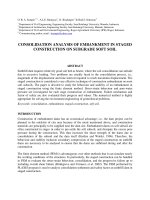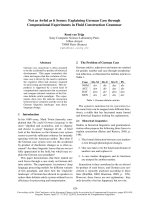Analyzing delay causes in Egyptian construction projects
Bạn đang xem bản rút gọn của tài liệu. Xem và tải ngay bản đầy đủ của tài liệu tại đây (681.07 KB, 7 trang )
Journal of Advanced Research (2014) 5, 49–55
Cairo University
Journal of Advanced Research
ORIGINAL ARTICLE
Analyzing delay causes in Egyptian construction
projects
Mohamed M. Marzouk *, Tarek I. El-Rasas
Structural Engineering Department, Faculty of Engineering, Cairo University, Egypt
A R T I C L E
I N F O
Article history:
Received 3 July 2012
Received in revised form 8 November
2012
Accepted 19 November 2012
Available online 28 January 2013
Keywords:
Construction management
Construction delays
Disputes and litigation
Statistical analysis
A B S T R A C T
Construction delays are common problems in civil engineering projects in Egypt. These problems occur frequently during project life-time leading to disputes and litigation. Therefore, it
is essential to study and analyze causes of construction delays. This research presents a list of
construction delay causes retrieved from literature. The feedback of construction experts was
obtained through interviews. Subsequently, a questionnaire survey was prepared. The questionnaire survey was distributed to thirty-three construction experts who represent owners, consultants, and contractor’s organizations. Frequency Index, Severity Index, and Importance Index
are calculated and according to the highest values of them the top ten delay causes of construction projects in Egypt are determined. A case study is analyzed and compared to the most
important delay causes in the research. Statistical analysis is carried out using analysis of variance ANOVA method to test delay causes, obtained from the survey. The test results reveal
good correlation between groups while there is significant difference between them for some
delay causes and finally roadmap for prioritizing delay causes groups is presented.
ª 2014 Cairo University. Production and hosting by Elsevier B.V. All rights reserved.
Introduction
Construction delay means a time overrun either beyond the
contract date or beyond the date that the parties have agreed
upon for the delivery of the project. In both cases, a delay is
usually a costly situation [1]. Delay was also defined as an
act or event which extends required time to perform or complete work of the contract manifests itself as additional days
of work [2]. Poor site management can cause project delay
* Corresponding author. Tel.: +20 2 35678492; fax: +20 2 33457295.
E-mail address: (M.M. Marzouk).
Peer review under responsibility of Cairo University.
Production and hosting by Elsevier
and affect productivity [3]. A lot of research efforts have been
made to study delay causes in different countries [4–15]. For
example, material-related delay is the main cause of project delays in Saudi Arabia [16]. Bordoli and Baldwin [17] examined
the causes of delays in building projects in the United States.
Weather, labor supply, and sub-contractors were found to be
the major causes of delays. Poor risk management, poor supervision, unforeseen site conditions, slow decision making
involving variation, and necessary variation works are the
principle delay factors in Hong Kong [18]. Unforeseen soil
condition, poor site supervision, low speed of decision making
involving all project teams, client initiated variations, necessary variations of work, and inadequate contractor experience
are the six significant factors contributing to delays in building
and civil engineering works [19]. Materials-, equipment-, and
labor-related delays were identified as major causes of contractors’ performance delays [20]. Design changes, poor labor
2090-1232 ª 2014 Cairo University. Production and hosting by Elsevier B.V. All rights reserved.
/>
50
productivity, and inadequate planning and resources were
found to be responsible for delays in Indonesia [21]. In Saudi
Arabia, contractor performance, owner’s administration, early
planning and design, government regulation, site and environment conditions, and site supervision were found to be the
important causes of delay [22]. Whereas, the financing and
payment for completed works, poor contract management,
change in site conditions, and shortages of materials were
found the most important items of delay causes in Nigeria
[23]. Odeyinka and Yusif [24] studied client-, contractor-,
and consultant-caused delays in housing projects in Nigeria.
Variation orders, slow decision making, and cash flow problems were found as client-caused delays. Financial difficulties,
material management problems, planning and scheduling
problems, inadequate site inspection, equipment management
problems and shortage of manpower were found as contractor-caused delays. Incomplete drawing, slow response by consultant, variation orders, late issuance of instruction, and poor
communications were classified as consultant-caused delays.
Inclement weather, act of God, labor dispute, and strikes were
found to be extraneous factors responsible for delays. Bramble
and Callahan [25] studied owner-, designed-, contractor-, and
others-related delays in U.S.A. Late release of site to the contractor, late approval, financial difficulties, contract administration responsibilities, change orders, and interference were
found to be owner-caused delays. Design defects, slow correction of design errors, tardy shop drawings review, and delays
due to test and inspection were considered to be designedcaused delay. Failure to evaluate the site and design, construction defects, contractor management problems, and inadequate resources were found to be contractor-related delays.
Weather, act of God, strikes, and labor disputes were found
to be delays not caused by the design and construction parties.
In Egypt, Amer [26] studied the major delay causes for construction projects which they are: poor contract management,
unrealistic scheduling, lack of owner’s financing/payment for
completed work, design modifications during construction,
and shortages in materials such as cement and steel. Abd ElRazek et al. [27] considered several delay causes in construction projects in Egypt which are: financing by contractor during construction, delays in contractor’s payment by owner,
design changes by owner or his agent during construction, partial payments during construction, and non-utilization of professional construction/contractual management. Marzouk et.
al. [28] studied delays that are related to engineering factors
which arise due to design development, workshop drawings,
and change then he developed a knowledge based expert system for assessing the engineering related delay claims. Kazaz
et al. [29] conducted a study on the causes oof time extensions
in the Turkish construction industry and levels of their importance, considering 34 factors. A questionnaire survey was conducted with 71 construction companies in Turkey, and the
outcomes were evaluated by means of statistical analyses.
Methodology
Delay causes survey
The questionnaire designed for use in the survey comprised
demographic information about respondents and 43 delay
causes which were grouped to seven categories: owner related,
M.M. Marzouk and T.I. El-Rasas
consultant related, contractor related, material related, labor
and equipment related, project related, and external related
(see Table 1). The respondents were requested to choose one
degree of frequency for each delay cause which is rarely, sometimes, often, or always. Also they were requested to choose one
degree of severity which is low, moderate, high, or extreme.
The questionnaire was distributed only to owners who are
representatives of large investment projects and affiliated to
first class of consultants who are classified as house of expertise
in the Egyptian Syndicate of Engineers as well as to contractors who are representatives to high class companies registered
in the Egyptian Federation for Construction and Building
Contractors (EFCBC). Total of 33 experts responded. The experts were divided into three groups each group consists of eleven experts the first group represents owners and the second
represents consultants while the third represents contractors.
All respondents hold senior positi��������������������������������������������������������������������������������������������������������������������������������������������������������������������������������������������������������������������������������������������������������������������������������������������������������������������������������������������������������������������������������������������������������������������������������������������������������������������������������������������������������������������������������������������������������������������������������������������������������������������������������������������������������������������������������������������������������������������������������������������������������������������������������������������������������������������������������������������������������������������������������������������������������������������������������������������������������������������������������������������������������������������������������������������������������������������������������������������������������������������������������������������������������������������������������������������������������������������������������������������������������������������������������������������������������������������������������������������������������������������������������������������������������������������������������������������������������������������������������������������������������������������������������������������������������������������������������������������������������������������������������������������������������������������������������������������������������������������������������������������������������������������������������������������������������������������������������������������������������������������������������������������������������������������������������������������������������������������������������������������������������������������������������������������������������������������������������������������������������������������������������������������������������������������������������������������������������������������������������������������������������������������������������������������������������������������������������������������������������������������������������������������������������������������������������������������������������������������������������������������������������������������������������������������������������������������������������������������������������������������������������������������������������������������������������������������������������������������������������������������������������������������������������������������������������������������������������������������������������������������������������������������������������������������������������������������������������������������������������������������������������������������������������������������������������������������������������������������������������������������������������������������������������������������������������������������������������������������������������������������������������������������������������������������������������������������������������������������������������������������������������������������������������������������������������������������������������������������������������������������������������������������������������������������������������������������������������������������������������������������������������������������������������������������������������������������������������������������������������������������������������������������������������������������������������������������������������������������������������������������������������������������������������������������������������������������������������������������������������������������������������������������������������������������������������������������������������������������������������������������������������������������������������������������������������������������������������������������������������������������������������������������������������������������������������������������������������������������������������������������������������������������������������������������������������������������������������������������������������������������������������������������������������������������������������������������������������������������������������������������������������������������������������������������������������������������������������������������������������������������������������������������������������������������������������������������������������������������������������������������������������������������������������������������������������������������������������������������������������������������������������������������������������������������������������������������������������������������������������������������������������������������������������������������������������������������������������������������������������������������������������������������������������������������������������������������������������������������������������������������������������������������������������������������������������������������������������������������������������������������������������������������������������������������������������������������������������������������������������������������������������������������������������������������������������������������������������������������������������������������������������������������������������������������������������������������������������������������������������������������������������������������������������������������������������������������������������������������������������������������������������������������������������������������������������������������������������������������������������������������������������������������������������������������������������������������������������������������������������������������������������������������������������������������������������������������������������������������������������������������������������������������������������������������������������������������������������������������������������������������������������������������������������������������������������������������������������������������������������������������������������������������������������������������������������������������������������������������������������������������������������������������������������������������������������������������������������������������������������������������������������������������������������������������������������������������������������������������������������������������������������������������������������������������������������������������������������������������������������������������������������������������������������������������������������������������������������������������������������������������������������������������������������������������������������������������������������������������������������������������������������������������������������������������������������������������������������������������������������������������������������������������������������������������������������������������������������������������������������������������������������������������������������������������������������������������������������������������������������������������������������������������������������������������������������������������������������������������������������������������������������������������������������������������������������������������������������������������������������������������������������������������������������������������������������������������������������������������������������������������������������������������������������������������������������������������������������������������������������������������������������������������������������������������������������������������������������������������������������������������������������������������������������������������������������������������������������������������������������������������������������������������������������ccording to Frequency Index.
Delay group
Cause
F.I
Owner related
Contractor related
Owner related
Owner related
Owner related
Contractor related
Labor & equipment
Contractor related
Project related
Owner related
1.7
3.3
1.6
1.3
1.5
3.2
5.3
3.1
6.1
1.1
68.94
68.94
66.67
65.15
64.39
64.39
64.39
63.64
62.12
57.58
Table 3
Type of project bidding and award (negotiation, lowest bidder)
Ineffective planning and scheduling of project
Variation orders/changes of scope by owner during construction
Late in revising and approving design documents by owner
Finance and payments of completed work by owner
Poor site management and supervision
Low productivity level of labors
Difficulties in financing project by contractor
Effects of subsurface conditions (e.g., soil, high water table, etc.)
Slow decision making
Top ten delay causes ranked according to Severity Index.
Delay group
Cause
S.I
Material related
External related
Owner related
Project related
Labor & equipment
Consultant related
Contractor related
Labor & equipment
Labor & equipment
Owner related
4.1
7.7
1.5
6.1
5.1
2.1
3.1
5.3
5.2
1.6
93.9
91.7
90.9
90.9
88.6
86.4
86.4
86.4
85.6
84.8
Shortage of construction materials in market
Fluctuations in cost/currency
Finance and payments of completed work by owner.
Effects of subsurface conditions (e.g., soil, high water table, etc.)
Shortage of labors
Inadequate experience of consultant
Difficulties in financing project by contractor
Low productivity level of labors
Unqualified workforce
Variation orders/changes of scope by owner during construction
Delay causes in construction projects
Table 4
53
Top ten delay causes ranked according to Importance Index.
Delay group
Cause
Imp.I
Owner related
Owner related
Project related
Labor & equipment
Contractor related
Contractor related
Owner related
Material related
Owner related
Labor & equipment
1.5
1.6
6.1
5.3
3.3
3.1
1.7
4.1
1.3
5.2
58.54
56.57
56.47
55.61
55.36
54.96
53.27
51.24
50.84
48.64
Table 5
Finance and payments of completed work by owner
Variation orders/changes of scope by owner during construction
Effects of subsurface conditions (e.g., soil, high water table, etc.)
Low productivity level of labors
Ineffective planning and scheduling of project
Difficulties in financing project by contractor
Type of project bidding and award (negotiation, lowest bidder)
Shortage of construction materials in market
Late in revising and approving design documents by owner
Unqualified workforce
Median and range of frequency for delay causes groups.
Delay causes group
Owner respondents
Consultant respondents
Contractor respondents
P value
Owner related
Consultant related
Contractor related
Material related
Labor & equipment related
Project related
External related
Total
21(12–31)
6(5–11)a
18(12–24)a
5(3–7)
8(5–10)
9(5–11)
13(9–18)
80(51–112)
24(11–28)
7(5–10)a
17(12–23)a
5(3–7)
8(5–11)
10(6–12)
12(8–17)
83(50–108)
24(15–31)
10(6–13)b
15(8–19)b
4(3–7)
7(4–11)
9(5–14)
12(8–20)
81(49–115)
0.369
0.024
0.059
0.925
0.368
0.891
0.764
0.966
Notes: The respondents group which has a different superscript b is significantly different from the other two respondents groups which have
superscript a (e.g. Causes group 2).
Table 6
Median and range of severity for delay causes groups.
Delay causes group
Owner related
Consultant related
Contractor related
Material related
Labor & equipment related
Project related
External related
Total
Owner respondents
Consultant respondents
a
a
28(18–36)
13(7–17)
22(15–27)
7(5–10)b
14(9–16)
14(8–17)
20(14–26)a
118(76–149)
28(18–37)
12(9–17)
25(17–30)
10(7–12)a
15(10–16)
17(11–19)
19(14–24)a
126(86–155)
Contractor respondents
b
36(23–38)
15(11–17)
23(16–29)
9(6–11)a
11(9–15)
16(10–18)
24(16–28)b
134(91–156)
P value
0.065
0.502
0.670
0.005
0.307
0.237
0.022
0.401
Notes: The respondents group which has a different superscript b is significantly different from the other two respondents groups which have
superscript a (e.g. Causes group 1).
Table 7
Median and degrees of Frequency Index and Severity Index.
Delay causes group
Owner related
Consultant related
Contractor related
Material related
Labor & equipment related
Project related
External related
Total
Frequency
Severity
Median
%
Degree
Median
%
Degree
23
7.67
16.67
4.67
7.67
9.33
12.33
81.34
28.28
9.43
20.49
5.74
9.43
11.47
15.16
100
V.H
L
H
V.L
L
L
M
––
30.67
13.33
23.33
8.67
13.33
15.67
21
126
24.34
10.58
18.51
6.88
10.58
12.44
16.67
100
V.H
L
H
V.L
L
L
M
––
54
M.M. Marzouk and T.I. El-Rasas
scope by owner during construction, slow decision making, effects of subsurface conditions (e.g., soil, high water table, etc.),
and type of project bidding and award (negotiation, lowest
bidder).
Consultants respondents
Fig. 2
Prioritizing delay causes groups roadmap.
to major difference between respondents’ opinions considering
P < 0.05. The results reveal that there are no differences in
opinions among opinions of experts for the three groups of
owners, consultants, and contractors in total and for each delay causes group which indicates that there is good correlation
between respondents with regard to delay causes groups in
general.
Table 7 lists the median values of Frequency Index and
Severity Index for each delay causes group. They are classified
according to its percentage as Very Low (V.L), Low (L), Medium (M), High (H), and Very High (V.H). The table indicates
that the frequency scores are in compliance with severity where
owner related delay causes has degree Very High and contractor related delay causes has degree High while external related
delay causes has degree Medium but delay causes related to
consultant, labor and equipment, and project have degree
Low while material related delay causes has degree Very
Low. Fig. 2 depicts the findings regarding the most important
delay causes groups of construction projects in Egypt. These
causes are prioritized regarding significance to five levels Very
High, High, Medium, Low, and Very Low.
Results and discussion
The results of questionnaire are analyzed to obtain the important causes of delays for owners, contractors, and consultants
respondents. These causes of delays are listed in below subsections.
Owners respondents
The important causes are; effects of subsurface conditions
(e.g., soil, high water table, etc.), low productivity level of labors, difficulties in financing project by contractor, ineffective
planning and scheduling of project, poor site management and
supervision, finance and payments of completed work by owner, type of project bidding and award (negotiation, lowest bidder), unqualified workforce, late in revising and approving
design documents by owner, and variation orders/changes of
scope by owner during construction. According to the considered case study, ‘‘variation orders/changes of scope by owner
during construction’’ is the most frequent delay cause which
is one of the top ten delay causes considered in the questionnaire. According to the findings of the questionnaire and case
studies, it is recommended for all project parties to avoid
occurrence of delay causes which lead to disputes.
The following recommendations might help accomplishing
delay reduction in construction projects:
For owners
- Specification of a realistic duration in the contract for the
contractor to execute the project.
- Having sufficient time to prepare feasibility study for the
project, as well as the preparation of a comprehensive
financial plan and cash flow.
- Obtaining the required approvals for the project from the
relevant authorities and ensure the availability of the necessary funding.
- Choosing a consultant to the project with sufficient experience in the field of work and has a good reputation.
- Making sure tender documents are complete, clear and free
of errors and/or contradiction.
- Payment of the dues to the contractor for the work being
carried as well as the payments of finished items according
to terms of the contract.
- Hiring an experienced contractor in the field of work who
has a good reputation.
For consultants
The important causes are; ineffective planning and scheduling
of project, difficulties in financing project by contractor, variation orders/changes of scope by owner during construction,
poor site management and supervision, type of project bidding
and award (negotiation, lowest bidder), low productivity level
of labors, effects of subsurface conditions (e.g., soil, high water
table, etc.), unqualified workforce, shortage of construction
materials in market, and delays in sub-contractors work.
Contractors respondents
The important causes are; finance and payments of completed
work by owner, late in revising and approving design documents by owner, owner interference, suspension of work, mistakes and discrepancies in design documents, shortage of
construction materials in market, variation orders/changes of
- Avoiding delaying the response to contractor’s queries as
well as the approval the submitted submittals and shop
drawings.
- Establishment of a control system to handle, control, and
evaluate variation orders, initiated by the owner.
For contractors
- Development of a comprehensive financial plan and cash
flow.
- Development of a monitoring and periodical reporting of
critical and long lead items and periodically providing a
narrative explanation of causes of any experienced delay.
- Choosing experienced subcontractors with good
reputation.
Delay causes in construction projects
- Development of a good system for site management and
supervision also develops effective planning and scheduling
for the project.
For all parties
- Project parties should preview the site Due-Diligence
Reviews and execution of necessary borings during the tender stage to make sure that the need for adjustments in
design or make amendments if necessary before the issuance of notice to proceed.
- Formal relationships among project parties should be
clearly identified, as well as roles and responsibilities.
Conclusion
This paper analyzed causes of construction delays in Egypt.
The feedback of construction experts was obtained through
interviews and questionnaire surveys. Frequency Index, Severity Index, and Importance Index are calculated and according
to the highest values of them the top ten delay causes of construction projects in Egypt are determined. Statistical analysis
is carried out using analysis of variance ANOVA method to
test delay causes, obtained from the survey. The most important delay causes groups of construction projects in Egypt
are prioritized according to their significance to five levels Very
High, High, Medium, Low, and Very Low. The survey results
were discussed. Finally, recommendations have been made to
construction projects’ parties to accomplish delay reduction
in construction projects.
Conflict of interest
The authors have declared no conflict of interest.
References
[1] O’Brien JJ. Construction delay: responsibilities, risk and
litigation. Boston, US: Cahners Books International, Inc.;
1976.
[2] Zack JG. Schedule delay analysis; is there agreement? In: Proc.
PMI-CPM college of performance spring conf., May 7–9, 2003,
Project Management Institute – College of Performance
Management, New Orleans, US; 2003.
[3] Pickavance K. Delay and disruption in construction contracts.
2nd ed. London, UK: Sweet & Maxwell; 2000.
[4] Doloi H, Sawhney A, Iyer KC, Rentala S. Analysing factors
affecting delays in Indian construction projects. Int J Project
Manager 2012;30(4):479–89.
[5] Sweis G, Sweis R, Abu Hammad A, Shboul A. Delays in
construction projects: the case of Jordan. Int J Project Manager
2008;26(6):665–74.
[6] Hamzah N, Khoiry MA, Arshad I, Tawil NM, Ani Che AI.
Cause of construction delay – theoretical framework. Procedia
Eng 2011;20:490–5.
[7] Kaliba C, Muya M, Mumba K. Cost escalation and schedule
delays in road construction projects in Zambia. Int J Project
Manager 2009;27(5):522–31.
[8] Sambasivan M, Soon YW. Causes and effects of delays in
Malaysian construction industry. Int J Project Manager
2007;25(5):522–31.
55
[9] Chan DWM, Kumaraswamy MM. Reasons for delay in civil
engineering projects––the case of Hong Kong. Hong Kong Inst
Eng Trans 1996;2(3):1–8.
[10] Dlakwa MM, Culpin MF. Reasons for overrun in public sector
construction projects in Nigeria. Int J Project Manager
1990;8(4):237–41.
[11] Ahmed SM, Azhar S, Kappagantula P, Gollapudi D. Delays in
construction: a brief study of the Florida construction industry.
In: ASC Proc. 39th annual conference, Clemson University,
Clemson, SC., US; 2003. p. 257–66.
[12] Al-Khalil MI, Al-Ghafly MA. Important causes of delays in
public utility projects in Saudi Arabia. J Constr Manage Econ
1999;17(5):641–55.
[13] Arditi D, Akan GT, Gurdamar S. Reasons for delays in public
projects in Turkey. J Constr Manage Econ 1985;3(2):171–81.
[14] Lo TY, Fung IWH, Tung KCF. Construction delays in Hong
Kong civil engineering projects. J Constr Manage Eng
2006;132(6):636–49.
[15] Mansfield NR, Ugwu OO, Doran T. Causes of delay and cost
overruns in Nigerian construction projects. Int J Project
Manager 1994;12(4):254–60.
[16] Assaf SA, Al-Khalil M, Al-Hazmi M. Causes of delay in large
building construction projects. J Constr Manage Eng
1995;11(2):45–50.
[17] Bordoli DW, Baldwin AN. A methodology for assessing
construction project delays. J Constr Manage Eng
1998;16(3):327–37.
[18] Chan DWM, Kumaraswamy MM. A comparative study of
causes of time overrun in Hong Kong construction projects. Int
J Project Manager 1997;15(1):55–63.
[19] Kumaraswamy MM, Chan DWM. Contributors to construction
delays. J Constr Manage Econ 1998;16(1):17–29.
[20] Abd-Majid MZ, McCaffer R. Factors of non-excusable delays
that influence contractors’ performance. J Manage Eng
1998;14(3):42–9.
[21] Kaming PF, Olomolaiye PO, Holt GD, Harris FC. Factors
influencing construction time and cost overruns on high-rise
projects in Indonesia. J Constr Manage Econ 1997;15:83–94.
[22] Al-Khalil M, Al-Ghafly M. Important causes of delay in public
utility projects in Saudi Arabia. J Constr Manage Econ
1999;17(5):647–55.
[23] Mansfield NR, Ugwu OO, Doran T. Causes of delays and cost
overruns in Nigerian construction project. Int J Project Manager
1994;12(4):254–60.
[24] Odeyinka HA, Yusif A. The causes and effects of construction
delays on completion cost of housing projects in Nigeria. J
Financ Manage Prop Constr 1997;2(3):310–44.
[25] Bramble BB, Callahan MT. Construction delay claims. 4th
ed. US: Aspen Publishers; 2011.
[26] Amer WH. Analysis and evaluation of delays in construction
projects in Egypt. MSc. thesis, Zagazig University, Egypt; 1994.
[27] Abd El-Razek ME, Bassioni HA, Mobarak AM. Causes of
delay in building construction projects in Egypt. J Constr Eng
Manage 2008;134(11):831–41.
[28] Marzouk M, El-Dokhmasey A, El-Said M. Assessing
construction engineering-related delays: Egyptian perspective.
J Prof Iss Eng Ed Pr 2008;134(3):315–26.
[29] Kazaz A, Ulubeyli S, Avcioglu N. Causes of delays in
construction projects in Turkey. J Civ Eng Manage
2011;18(3):426–35.
[30] Kish L. Survey sampling. NY, US: John Wiley & Sons Inc.;
1965.
[31] Assaf SA, Al-Hejji S. Causes of delay in large construction
projects. Int J Project Manager 2006;24(11):349–57.









